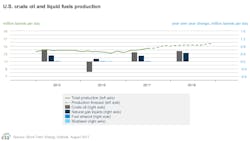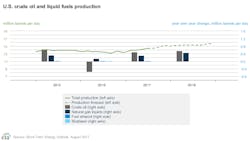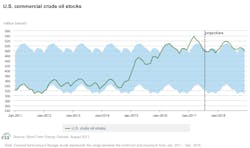Drilling activity in the US, as measured by the Baker Hughes active oil rig count, increased by 10 rigs in July—the fewest monthly oil rig additions since the rig count began increasing in June 2016. Some US exploration and production companies recently announced less investment spending for the rest of the year, suggesting the current rate of US oil production growth could slow.
In its latest Short-Term Energy Outlook, the US Energy Information Administration forecasts that month-over-month crude oil production increases for the Lower 48 states onshore region will slow to an average of 60,000 b/d in this year’s second half compared with estimated average monthly growth of 110,000 b/d in this year’s first half.
Although crude oil prices were further supported as Saudi Arabia announced a cap on the country’s crude oil exports to Asia, it is unclear how much extra crude oil this cap would remove from the market, given the country’s typical seasonal decline in crude oil exports because of an increase in crude oil use for power generation, EIA said. Meanwhile, Libya and Nigeria, two other members of the Organization of Petroleum Exporting Countries, continue to increase crude oil production—a contributing factor in keeping prices near $50/bbl.
EIA now forecasts global liquid fuel production to rise by 1.4 million b/d in 2017 and by 1.6 million b/d in 2018, supported by strong expected global economic growth. Second quarter gross domestic product increased 2.6% at a seasonally adjusted annual rate in the US and rose a respective 6.9% and 2.1% year-over-year in China and the Eurozone.
In July, total commercial petroleum inventories in the Organization for Economic Cooperation and Development countries are estimated to have declined by the most year-over-year since April 2014. In the US, commercial crude oil stocks fell to 481.9 million bbl during the week ended July 28, which was 95 million bbl above the 5-year average. In recent weeks, US crude oil inventories reached the closest to the 5-year average since September 2015. US refineries have been running at record highs this year, with crude oil inputs averaging 17.3 million b/d for the four weeks ended July 28, contributing to the inventory decline and the flattening crude oil futures price curve.
North Sea Brent crude oil spot prices averaged $48/bbl in July, $2/bbl higher than the June average and almost $4/bbl higher than in July 2016. In its August STEO, EIA forecasts Brent spot prices to average $51/bbl in 2017 and $52/bbl in 2018. West Texas Intermediate crude oil prices are forecast to average $2/bbl less than Brent prices in both 2017 and 2018. These forecasts are little changed from forecasts in the previous month.



